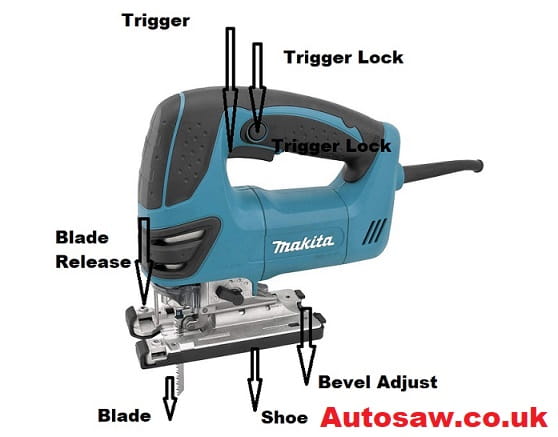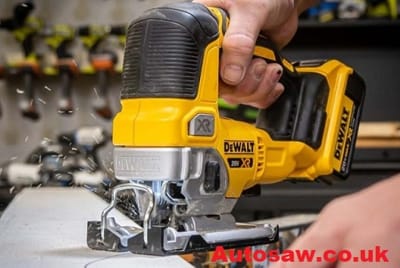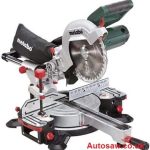As an Amazon Associate, I earn from qualifying purchases.

If you need to cut a straight line with a jigsaw, there are a few things you can do to ensure a successful cut. First, clamp the workpiece to a stable surface. This will help to keep it from moving while you’re cutting. Second, use a guide rail or straight edge to help guide the jigsaw along the cutting line. Finally, take your time and go slowly to avoid mistakes.
Contents
How To Cut Straight With a Jigsaw?
Choosing the Right Blade for Your Jigsaw
Choosing the right blade for your jigsaw is crucial for achieving straight and precise cuts. Blades are available in different lengths, widths, and materials, and they are designed for specific applications. To cut straight lines, you should use a blade with a narrow width and fine teeth. A narrow blade will reduce the amount of blade wander, while fine teeth will provide a smoother finish.
Marking the Cut Line
Before making any cuts, it is essential to mark the cut line on the material. Use a straightedge or a square to ensure that the line is straight and accurate. It is recommended to mark the line on the side of the material that will not be visible to avoid leaving visible marks.
Securing the Material
Securing the material is crucial to prevent it from moving while cutting. You can use clamps or a vise to hold the material in place. Make sure that the material is securely clamped and will not move while cutting. This will ensure that the cut is straight and precise.
Proper Stance and Body Position
To achieve a straight cut, it is essential to maintain a proper stance and body position. Stand in a comfortable and stable position with your feet shoulder-width apart. Hold the jigsaw with both hands and keep your arms close to your body. This will provide stability and control while cutting.
Starting the Cut
To start the cut, turn on the jigsaw and gently lower the blade onto the material. Begin cutting slowly and carefully to avoid the blade from wandering off the cut line. Make sure that the blade is perpendicular to the material to achieve a straight cut.
Following the Cut Line
While cutting, it is crucial to follow the cut line precisely. Keep your eyes on the cut line and use the jigsaw’s base plate to guide the blade. If necessary, stop cutting and adjust the jigsaw’s position to follow the line accurately.
Maintaining Blade Contact with the Material
Maintaining blade contact with the material is essential to ensure a straight cut. Keep the blade in contact with the material throughout the cut to prevent blade wander. If the blade wanders off the cut line, stop cutting, adjust the blade’s position, and continue cutting.
Controlling the Speed of the Jigsaw
Controlling the speed of the jigsaw is crucial to achieve a straight cut. If you are cutting through a thick material, you should lower the speed of the jigsaw to prevent the blade from bending. Cutting at a slower speed will also allow you to have better control over the jigsaw and the blade. On the other hand, cutting at a high speed is ideal for cutting through thin materials.
Handling Curves and Corners
When cutting curves and corners, it is crucial to slow down the speed of the jigsaw. This will provide you with more control over the blade, allowing you to follow the curve or corner accurately. If you are cutting a tight curve, you can also use a narrower blade to achieve a tighter radius.
Sanding and Finishing the Cut
After making the cut, you may need to sand and finish the material. Use sandpaper or a sanding block to smooth out any rough edges or surfaces. If you need to create a bevel or chamfer on the material, you can use a router or a chamfer bit.
Jigsaw Safety Precautions
It is essential to take safety precautions when using a jigsaw. Always wear protective gear, including safety glasses, gloves, and earplugs. Make sure that the jigsaw is turned off when changing the blade or adjusting the position. Never touch the blade or the motor while the jigsaw is in use. Also, keep your hands and fingers away from the blade to avoid injury.
Common Mistakes to Avoid
Some common mistakes to avoid when cutting straight with a jigsaw include using the wrong blade, not securing the material, cutting too fast, and not following the cut line accurately. Always choose the right blade for the material you are cutting, and make sure that the material is securely clamped. Cut at a moderate speed, and follow the cut line precisely to achieve a straight cut.
FAQs
Can I use a jigsaw to cut through metal?
Yes, you can use a jigsaw to cut through metal, but you will need to use a metal-cutting blade.
How do I choose the right blade for my jigsaw?
Choose a blade that is narrow and has fine teeth for straight cuts.
Can I use a jigsaw for bevel cuts?
Yes, you can use a jigsaw for bevel cuts by tilting the base plate or using a bevel guide.
Can I use a jigsaw to make plunge cuts?
Yes, you can use a jigsaw to make plunge cuts by lowering the blade onto the material and then starting the jigsaw.
What should I do if the blade starts to bend while cutting?
Slow down the speed of the jigsaw to prevent the blade from bending, or use a thicker blade for thicker materials.
Conclusion
Cutting straight with a jigsaw can be a tricky process, but with the right technique and the right tools, it can be done. In this article, we have discussed some of the tips and tricks that you can use to make sure that your jigsaw cuts are as straight as possible. We have also discussed some of the tools available to help you achieve this goal. With these tips and tools in hand, you should now be able to confidently cut straight lines with your jigsaw.





